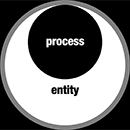Don’t worry, I’m not about to turn mystical.
However, I think that I have spotted a pattern which may be key in understanding what the universe is (what its components are) and what the universe does (what its components do). The “answer to the ultimate question of life, the universe, and everything” is not 42: it is 3.
Below I’ll attempt to sketch out each one of three trichotomies that seeks to exhaustively explain what everything is, how everything works, how that cycle continues — without bounds.
The triadic trichotomies:
- Key Ontologies: the 3 metaphysical axioms.
- Key Mechanics: the 3 ways these axioms work.
- Key Ontological Mechanics: the 3 products (triangulations) of this work.
The above trichotomies are set out row by row;
(1) ontologies;
(2) mechanics;
(3) mechanical ontologies.
Looking vertically…
The first column (outer-white, inner-black circles) I’ll call the ‘Metaphysical Purview’.
The second column (grey) I’ll call the ‘Neutral’ (or ‘Sameness=Nothingness’) column.
The third column (outer-black, inner-white circles) I’ll call the ‘Epistemological Purview’.
In the uppermost left, Existence ‘holds’ Consciousness: metaphysically Existence is primary (conscious minds might subsequently evolve from something that already exists).
In the uppermost right, Consciousness ‘holds’ Existence: epistemologically Consciousness is primary (we know about the universe; the universe doesn’t know about us).
Sandwiched between is no differentiation between Existence and Consciousness: rather than Identity (which both outer roundels manifest), the greyness represents their absolute opposite.
Likewise, the next two rows maintain the same Metaphysical, Neutral and Epistemological Purviews, conveying mereological whole/part relationships, regarding analogue/digital ‘mechanics’ and entity/process ‘ontological mechanics’ (for want of a better phase).
An explanation with a bit more substance…
1/3. Key Ontologies
Ontology — that aspect of metaphysics focused upon being, what exists.Objectivist metaphysics lists a triad which are self-evident, axiomatic ontologies:
- Existence (exists);
- Identity (that which all existents ‘have’);
- Consciousness (the information process identifying that which exists).
(Google metaphysical+axioms+objectivism)
So far, so good?
2/3. Key Mechanics
Mechanics — in the widest sense of how stuff works (not just motion and forces but information and threshold categorisation).This draws on Information Theory (my own cursory summation):
- Analogue;
- A Difference That Makes A Difference;
- Digital.
These three interrelations require a bit more explanation.
Digital is the easiest to explain, it’s typically thought of as the 1s and 0s at the basis of all computing, of absolute on/off certainty. A digital description of the universe would be one composed of discrete, clearly delineated entities, ultimately finite.
Analogue is the opposite, a continuously variable physical quantity with imprecise boundaries, no matter at what scale. An analogue description of the universe would be of a continuum, with a boundless scale in space and time. It could still be thought of in terms related to 1 and 0, but never absolute 1 or absolute 0, rather all the limitless values in-between.
The third element, like Identity in the first triad, neatly bridges the other two, is “A Difference That Makes A Difference” — which happens to be the title of this blog. Under a digital purview, this is simply the difference between 1 and 0, that’s the only thing that makes any difference in Digit-land. But in misty Analogue-land, the threshold between making a difference or not is less rigidly systematised, it is more contextual. There can still be objective thresholds, but there’s a shifting contextual fuzziness to when and where these bounds actually fall.
So far this explanation relates to Existence in the first triad, with an allusion to Identity. However, Consciousness, as an information process, relates to this mechanical triad. In my opinion Consciousness ‘converts’ an ultimately analogue universe into digestible digital bites. The evidence is in our neurology: a complex self-organising (connecting and pruning) network of, essentially, on/off switches, but affording us the richness of all our experiences. Ultimately, our epistemology is built upon binary foundations, the thresholds involved are synaptic potentials. Indeed, all information (to be informative) must be about digitalisation: distinguishing, categorising, contrasting, pattern-making.
Furthermore, I think it works through minimising prediction error — but that’s for another day.
3/3. Key Ontological Mechanics
Tying together ontology and mechanics, being and doing:- Process;
- Spacetime Difference;
- Entity.
I’m now going to get provocative: out of the ontology and their integrated mechanics we get three ‘things’; space, time and spacetime.
Now I really need to explain myself!
I view this as another triangulation in which each element logically ‘generates’ the other two.
By ‘spacetime’ I mean no difference between the spacial and temporal dimension. I mean similitude, I mean greyness, I mean no identity, no difference to make a difference (and I acknowledge that this isn’t what is usually meat by spacetime).
By space I mean an entity that can (in some way) be distinguished from a process. Any concrete entity, or ‘space’ between entities is the spacial aspect.
By time I mean process that can (in some way) be distinguished from an entity. Any measurable change undergone by any entity is the temporal aspect.
Notice that space is entirely defined in contrast with time (and spacetime similitude), and that time is entirely defined in contrast with space (and, again, spacetime similitude). Time has to subtract the spacial, it occurs in ‘a single space’; space has to subtract the temporal, it occurs at ‘a single time’. My definition of ‘spacetime’ blends them into ‘nothing-ness’.
Here’s a few seemingly paradoxical nuggets to juggle with…
Entity is about difference in space.
(Back in April I casually referred to entities as thicker zones, contrasted with thinner zones— more-or-less ‘empty space’).
Process is about difference in time.
(I also referred to process as slower zones, contrasted with faster zones — more-or-less ‘no time’)
Spacetime differential means the process of entity differentiation (out of otherwise spacetime similitude).
All entities are actually always processes; all processes are actually always about entities.
Thoughts?











